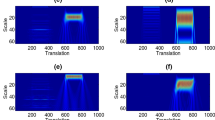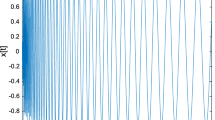Abstract
In this paper, multi-resolution Fourier analysis, labeled NY-MFA, suitable for time-varying spectra is proposed. It is shown that increasing time resolution has no detrimental effects on frequency resolution and achieved resolution bounds are in excess of Gabor–Heisenberg limit. Observation results with their increased time resolution, discriminated and precise frequency contents justify thoroughly the assumption of stationarity and consequently approach more precisely the concept of frequency and its changes than wavelets and short-term Fourier transform can do.




Similar content being viewed by others
References
Grochenig, K.: Foundations of Time-Frequency Analysis. Birkhauser, Boston, MA (2001)
Portnoff, M.: Time-frequency representation of digital signals and systems based on short-time Fourier analysis. IEEE Trans. Acoust. Speech Signal Process. 28(1), 55–69 (1980)
Jones, D.L., Parks, T.W.: A resolution comparison of several time-frequency representations. In: International Conference on Acoustics, Speech, and Signal Processing, vol. 4, pp. 2222–2225. ICASSP-8, 23–26 May, 1989
Cohen, L.: Time-Frequency Analysis. Prentice-Hall, Englewood Cliffs, NJ (1995)
Nawab, S., Quatieri, T., Lim, J.: Signal reconstruction from short-time Fourier transform magnitude. IEEE Trans. Acoust. Speech Signal Process. 31(4), 986–998 (1983)
Portnoff, M.: Short-time Fourier analysis of sampled speech. IEEE Trans. Acoust. Speech Signal Process. 29(3), 364–373 (1981)
Portnoff, M.: Implementation of the digital phase vocoder using the fast Fourier transform. IEEE Trans. Acoust. Speech Signal Process. 24(3), 243–248 (1976)
Qian, S., Chen, D.: Joint time-frequency analysis. IEEE Signal Process. Mag. 16(2), 52–67 (1999)
Hlawatsch, F., Boudreaux-Bartels, G.F.: Linear and quadratic time-frequency signal representations. IEEE Signal Process. Mag. 9, 21—67 (1992)
Almeida, L.B.: The fractional Fourier transform and time-frequency representations. IEEE Trans. Signal Process. 42(11), 3084–3091 (1994)
Priestley, M.B.: Non-linear and Non-stationary Time Series Analysis. Academic Press, London (1988)
Gabor, D.: Theory of communication. J. Inst. Electron. Eng. 93(11), 429–457 (1946)
Cohen, L.: Generalized phase space distribution functions. J. Math. Phys. 7(5), 781–786 (1966)
Wigner, E.P.: On the quantum correction for thermodynamic equilibrium. Phys. Rev. 40, 749–759 (1932)
Claasen, T.A.C.M., Mecklenbräuker, W.F.G.: The Wigner distribution, a tool for time-frequency analysis, Part I: continuous-time signals. Philips J. Res. 35(3), 217–250 (1980)
Goupillaud, P., Grossman, A., Morlet, J.: Cycle-octave and related transforms in seismic signal analysis. Geoexploration 23, 58–102 (1984)
Daubechies, I.: The wavelet transform, time-frequency localization and signal analysis. IEEE Trans. Inf. Theory 36, 961–1005 (1990)
Auger, F., Flandrin, P.: Improving readability of time-frequency and time-scale representations by the reassignment method. IEEE Trans. Signal Process. 43(5) (1995)
Meyer, Y.: Wavelets: algorithms and applications. Society for Industrial and Applied Mathematics, Philadelphia (1993)
Rioul, O., Vitterli, M.: Wavelets and Signal Processing. IEEE Signal Process. Mag. 8(4), 14–38 (1991)
Daubechies, I.: Ten Lectures on Wavelets. SIAM, Philadaphia, PA (1992)
Daubechies, I.: The wavelet transform, time-frequency localization and signal analysis. IEEE Trans. Inf. Theory 36(5), 961–1005 (1990)
Strang, G.: Wavelet transforms versus Fourier transforms. Bull. Amer. Math. Soc. 28, 288–305 (1993)
Yahya Bey, N.: Multi-resolution Fourier analysis, Part I: fundamentals. Int. J. Commun. Netw. Syst. Sci. 4(6), 364–371 (2011)
Yahya Bey, N.: Multi-resolution Fourier analysis, Part II: missing signal recovery and observation results. Int. J. Commun. Netw. Syst. Sci. 5(1), 28–36 (2012)
Yahya Bey, N.: Multi-resolution Fourier analysis: extraction and missing signal recovery of short buried signals in noise. In: Signal Image and Video Processing (SIViP). Springer, Berlin (October 2012)
Calway, A.D., The Multiresolution Fourier Transform: A General Purpose Tool for Image Analysis. Ph.D Thesis, Warwick Univ. (1989)
Pearson, E.R.S.: The Multiresolution Fourier Transform and Its Application to the Analysis of Polyphonic Music. Ph.D. Thesis, Warwick Univ. (1991)
Wilson, R., Calway, A.D., Pearson, E.R.S.: A generalized wavelet transform for fourier analysis: the multiresolution fourier transform and its application to image and audio signals. IEEE Trans. Image Process. 38, 674–690 (1992)
Sparto, P.J., Parnianpour, M.: Wavelet and short-time Fourier transform analysis of electromyography for detection of back muscle fatigue. IEEE Trans. Rehab. Eng. 8(3), 433–436 (2000)
Gramatikov, B., Georgiev, I.: Wavelets as alternative to short-time Fourier transform in signal-averaged electrocardiography. Med. Biol. Eng. Comput. 33(3), 482–487 (1995)
Zhang, Y., Guo, Z., Wang, W., He, S., Lee, T., Loew, M.: A comparison of the wavelet and short-time fourier transforms for Doppler spectral analysis. Med. Eng. Phys. 25(7), 547–557 (2003)
Acknowledgments
The author would like to thank anonymous reviewers for their pertinent questions, helpful comments and valuable discussions.
Author information
Authors and Affiliations
Corresponding author
Appendices
Appendix A
Here, we use the only observed stationary signal \(x_T(t)\) in the time interval of length \(T\) to construct a double resolution signal for which \(T\Delta B=1/2\) is satisfied. We propose “one-point” interpolation followed by zeros insertion in the frequency domain [24]. Notice that we propose here a simpler formulation of original computations appearing in [24].
1.1 One-point interpolation
Given \(x_T(t)\), let us construct the overall signal defined in \([0, 2T]\) as follows,
where \(z_T(t)=0\), \(\forall t\in [0, T]\) and \(\Pi _{2T}(t)\) is the rectangular window of length \(2T\). By writing \(\widehat{x}_{2T}(t)\) as a function of the true signal \(x_{2T}(t)\), we obtain,
One can see easily that (27) can be put under the form,
where the window \(w_{2T}(t)\) is given by,
and \(\xi _{2T}(t)=\Pi _T(t)-\Pi _T(t-T)\).
1.2 Zeros insertion in the frequency domain
In order to insert zeros on the frequency axis able to define the bounded support, \(1/(2T)\), we introduce a local period by substituting \(4T\) for \(2T\) in the subscripts of (28). This gives,
It is easy to see that \(w_{4T}(t)\) has the following Fourier transform,
where \(H_{\Pi _4}(f)\) and \(H_{\xi _{4}}(f)\) are, respectively, Fourier transforms of \(\Pi _{4T}(t)\) and \(\xi _{4T}(t)\), i.e.,
where \(S(x)=\sin (x)/x\). The complex exponential \(\phi _{\Pi _4}(f)\) represents phase induced by the absolute position of the time interval on the timescale. Notice that,
1.3 Bandwidth
Here, our aim is to derive the bandwidth of \(W_4(f)\) as given by (31). Notice that \(W_4(f)\) consists of two terms. Let us consider the first term \(H_{\Pi _4}(f)\). One can see from (32) that the interval for which \(S(4\pi f T)=0\) for \(f=k/(4T)\) where \(k\pm 1\) is given by \(1/(2T)\). Now, the bandwidth, defined as the main lobe width between 3-dB or \(1/\sqrt{2}\) of \(H_{\Pi _4}(f)\), is so that,
On the other hand,
and particularly for points defining the bandwidth of \(H_{\Pi _4}(f)\), we have,
The bandwidth remains unchanged by the additional term \(H_{\xi _{4}}(f)\). It follows from (34) and (36) that the bandwidth of \(W_{4}(f)\), as given by (31), is so that,
1.4 Double resolution properties
By considering (30) in the frequency domain, we can write,
where FT\([x]\) is the Fourier transform of \(x\). Here \(X(f)\) and \(H_{\Pi _{2}}(f)\) are, respectively, Fourier transforms of the signal \(x(t)\) and the rectangular window \(\Pi _{2T}(t)\) of length \(2T\). Notice that \(X(f)\), the true amplitude spectrum, is assumed bandlimited. Here the term \(\theta (2fT)\) resulting from time translations is given by,
Notice that \(\theta (2fT)\), as given by (39), defines the amplitude spectrum at the frequency locations \(f=k/(4T)\). We have,
where \(p=0,\pm 1,\pm 2\ldots \).
Now, convolution between the windows \(H_{\Pi _{2}}(f)\) and \(W_{4}(f)\) whose bandwidths are, respectively, given by \(1/(2T)\) and \(1/(4T)\) yields a window with the broadest of the two bandwidths. According to (37), this gives
where the bandwidth of \({H}(f,1/(2T))\) is specified by its second argument \(1/(2T)\).
As shown by (42), the true spectrum \(X(f)\) is convolved with the filter \({H}(f,1/(2T))\) whose bandwidth is \(1/(2T)\). This yields the twofold resolution spectrum \(\widehat{X}(f)\) for which,
where \(T\) and \(\Delta B\) are widths in time and frequency domains.
Extraction of the twofold amplitude spectrum \(X(f,1/(2T))\) of the signal is detailed in appendix B.
1.5 Expression of double resolution signals
By considering (30), the double resolution signal is given by,
Here (43) can be written as a function of \(x_T(t)\) as follows,
which is given by \(\mathfrak {R}_{(s)}[x_T(t)]\) for \(s=2\). Derivation of remaining multi-resolution signals for \(s=3,4,5\) is detailed in [24].
Appendix B
1.1 General case
Here, we extract the amplitude spectrum \(X(f)\) of the signal \(x(t)\) up to the resolution \(1/(sT)\). We start by generalizing (42) to any level of resolution. This gives,
where,
and \(W_{2s}(f)\) is given by,
By setting (47), (45) yields the two terms,
For the sake of simplicity, let
By using (49), we can rewrite (48) under the form,
Our aim, now, is to extract the spectrum \(X(f)\) of the signal up to the resolution \(1/(sT)\).
1.2 The spectrum of the signal
According to (49), \(X(f)\) is involved in the expressions of \(X_{\Pi }(f,1/(sT))\) and \(X_{\xi }(f,1/(sT))\). Generalization of the important relation given by (33) to any level of resolution “\(s\)” yields,
Here (51) helps to find the convenient filtering able to extract \(X(f)\) up to the resolution \(1/(sT)\). Clearly, inequality (51) shows that spectral lines of \(X_{\Pi }(f,1/(sT))\) are much more powerful than those of \(X_{\xi }(f,1/(sT))\). Hence, the second right-hand side of (50) can be discarded and the first right-hand side preserved. Convenient filtering is therefore thresholding. We have shown in [25, 26] that thresholding (hard or soft) applied to simulated and experimental signals works for extraction of the amplitude spectrum of the signal. This is also observed in this work.
1.3 Frequency resolution
Consider the first right-hand side of (50). Convolution between transforms \(H_{\Pi _{s}}(f)\) and \(H_{\Pi _{2s}}(f)\) yields a transform with the broadest \(1/(sT)\) of the two bandwidths. This gives,
Since \(\forall \,f=k/(2sT)\), we have,
where \(p=0,\pm 1,\pm 2,\ldots \), then,
One can see immediately that since \(H_{\Pi {_{s}}}(f)\) is the transform of the rectangular window \(\Pi _{sT}(t)\), the true amplitude spectrum of the signal defined for the resolution \(1/(sT)\) is represented by (54), i.e.,
where \(p=0,\pm 1,\pm 2\ldots \).
Rights and permissions
About this article
Cite this article
Yahya Bey, N. Multi-resolution Fourier analysis: time-frequency resolution in excess of Gabor–Heisenberg limit. SIViP 8, 765–778 (2014). https://doi.org/10.1007/s11760-013-0582-7
Received:
Revised:
Accepted:
Published:
Issue Date:
DOI: https://doi.org/10.1007/s11760-013-0582-7




